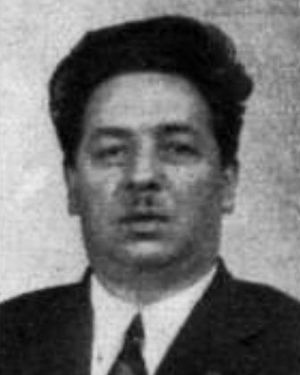Hugo Gräf facts for kids
Quick facts for kids
Hugo Gräf
|
|
|---|---|

Gräf circa 1930
|
|
| Born | 10 October 1892 |
| Died | 23 October 1958 |
| Occupation | Politician |
| Political party | SPD (1910) USDP (1917) KPD (1918) SED (1946) |
| Spouse(s) | Herta |
| Children | Arno Gräf (1932) |
Hugo Gräf (born October 10, 1892, died October 23, 1958) was a German politician. He was a member of the Communist Party and later the Socialist Unity Party. Gräf spent his life working for the rights of workers and war victims. He faced many challenges, including imprisonment and exile, but continued his political work.
Contents
Life of Hugo Gräf
Early Life and Work
Hugo Gräf was born in a small village called Rehestädt. This village was about 20 kilometers (12 miles) south of Erfurt in central Germany. His father worked in building, and his mother worked on farms and in homes.
From 1902, Gräf worked as a farm helper. Later, he trained to be a pipefitter. This job allowed him to travel for work. In 1907, he joined the German Metal Workers' Union. On May 1, 1910, he became a member of the Social Democratic Party.
Military Service and New Political Ideas
In 1912, Hugo Gräf joined the army. His service was supposed to last two years. However, World War I started in August 1914, and he had to stay in the army. In 1916, he was badly hurt and lost his left leg.
In 1916 and 1917, he worked in a gun factory in Erfurt. Here, in 1917, he joined a new group called the Independent Social Democratic Party of Germany (USPD). This party had split from the main Social Democratic Party because they disagreed about supporting the war. He also joined the Spartacus league around 1917 or 1918.
Leading Strikes and Founding a Party
In January 1918, Gräf helped organize big strikes in Erfurt. These strikes happened across much of Germany that month. Being part of the USPD and Spartacus League led him to the new Communist Party (KPD). On December 26, 1918, Gräf helped start the Erfurt branch of the Communist Party.
In June 1920, Gräf was removed from the Communist Party. This happened because he refused to run for a seat in the Reichstag, which was the national parliament. He was allowed back into the KPD in 1923.
Helping War Victims and Becoming a Member of Parliament
Gräf continued to work with the International League of Victims for Victims of War and of Work (IB). He had helped start the Erfurt branch of this group in 1919. In April 1927, he became the national leader of the IB. He led this group until it was banned in 1933.
In the 1928 election, Hugo Gräf ran as a Communist Party candidate. He was elected to represent the Dresden-Bautzen area in the Reichstag. He won his seat again in the election of March 5, 1933. However, the new Nazi government immediately cancelled the election results for Communist candidates.
Facing Difficult Times
Less than three weeks after the March 1933 election, new laws were passed. These laws created a one-party government in Germany, led by the Nazi Party. Other parties were banned. Communist politicians from the Weimar period were targeted by the new government.
On March 13, 1933, Gräf was arrested in Dresden. He was held in special custody until June 24, 1935. He was first held in an interrogation camp in Dresden. From November 1933, he was moved to Colditz. He was later transferred to Sachsenburg in May 1934. There, he worked in the book-binding workshop.
Exile and Continued Activism
In 1935, Gräf studied in Moscow. Four months after being released, he escaped to Czechoslovakia in October 1935. He stayed in Czechoslovakia until 1938. When Germany took over the Sudetenland region, he moved to Great Britain. There, he joined other German Communist Party members who were also in exile.
He continued his political work and led the local branch of the Rote Hilfe, a humanitarian group. In September 1939, World War II began. The British government arrested many German political exiles, seeing them as "enemy aliens." From July 1940 to October 1941, Gräf was held on the Isle of Man. Later, he started an "Emigrants' Club" in Glasgow and worked as a toolmaker. He joined other exile groups, including the "Free German Cultural Association." On September 25, 1943, he helped found the British part of the "Free Germany movement."
Life After World War II
After World War II ended in May 1945, Gräf returned home in August 1946. His home was now in the Soviet occupation zone of Germany. This area later became the German Democratic Republic (East Germany) in October 1949.
In April 1946, the old Communist Party (KPD) and the Social Democratic Party (SPD) joined together. They formed a new party called the Socialist Unity Party of Germany (SED). This merger created the basis for a one-party government. Hugo Gräf had been a long-time member of the Communist Party. He quickly joined the new Socialist Unity Party.
In 1946, he became a consultant for the health department of the government's Central Secretariat. By 1948, he was a department head. He helped create the Health Service of the Trade Union Federation (FDGB). On July 5, 1949, he became its first president, serving until 1951.
Later Years and Legacy
In 1950, he joined the executive board of the FDGB. From 1951 to 1953, he was a senior regional administrator (Landrat) in Gotha, Thuringia. However, he resigned in May 1953 due to health reasons. This followed a disagreement with local party leaders about plans to rebuild the municipal theater in Gotha, which had been damaged by bombing.
Despite this, he returned to local politics. He served as a member of the Party Regional Leadership in Gotha from 1955 until 1958. Hugo Gräf passed away on October 23, 1958.

